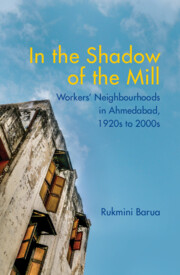5 - Chawls Without Chimneys
Published online by Cambridge University Press: 15 June 2022
Summary
As mill chimneys were beginning to sprout across the city at the turn of the previous century, workers’ neighbourhoods bloomed in a crescent along the railway line connecting Ahmedabad and Bombay. The phenomenal demographic growth of the early twentieth century, largely propelled by the expansion of the textile industry, was accompanied by a host of civic and urban issues—of housing, sanitation, urban transport and overcrowding. The city municipality, led largely by the local elite, launched a set of initiatives to tackle the changed urban situation. The urban body ‘opened up’ the overcrowded heart of the city, restructured the pols, marked distinctions between public and private space, conducted a city survey, documented property rights and revised valuations of private property. Land within the walled city became increasingly profitable and landlords, eager to invest in real estate and immovable property. The ‘mud and straw hovels’ of the urban poor and industrial workers were gradually shunted beyond the city limits. The process of incorporating the outlying, suburban areas into the municipal limits was staggered and uneven. In 1858, Hathipura, Madhavpur and Rajpur (which includes parts of present-day Rajpur-Gomtipur) were included within the city boundaries, before being excluded two years later. In 1881, the civic limits expanded again to absorb some textile mills and the railway station. Over the next twenty years, new residential settlements on the western banks as well as industrial localities towards the east of the Sabarmati were brought within the ambit of municipal regulations and taxation. This expansion and reorganisation of the city were not without resistance and protest. The opposition to spatial reorganisation and increased taxation precipitated a crisis of authority within the municipality, which was, at one level, mobilised by the Congress Party, led by Vallabhai Patel to wrest control of the civic body in 1919.
SETTLING THE MILL NEIGHBOURHOODS
As early as 1890, the municipality recognised the need for organised chawl housing for the burgeoning population. After building some model chawls, their enthusiasm petered out. The housing question remained a pressing concern, acquiring greater urgency through the politically turbulent decade of the 1920s. This attention to workers’ accommodation and social welfare was propelled, in part, by an unsuccessful strike in 1923 (which led to a 15 per cent reduction in wages) and the TLA's entry into municipal politics in 1924.
- Type
- Chapter
- Information
- In the Shadow of the MillWorkers' Neighbourhoods in Ahmedabad, 1920s to 2000s, pp. 178 - 212Publisher: Cambridge University PressPrint publication year: 2022

